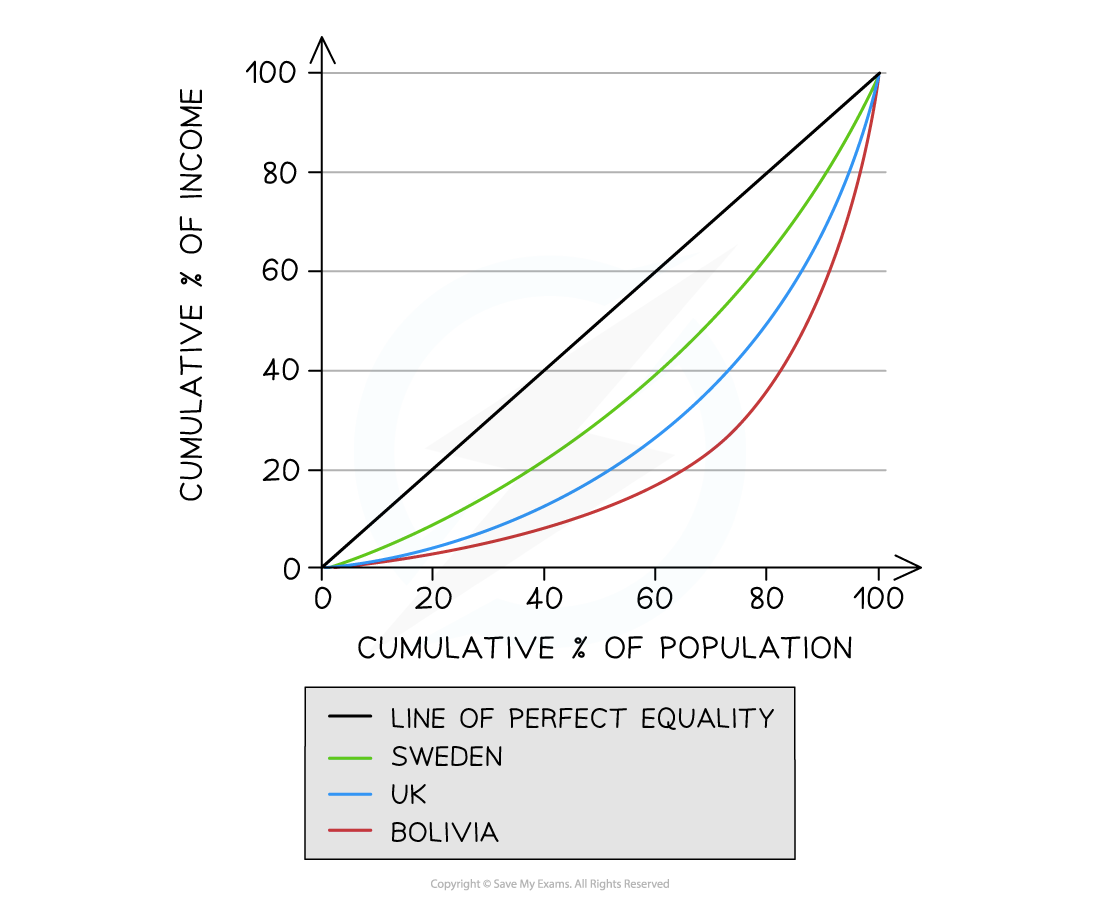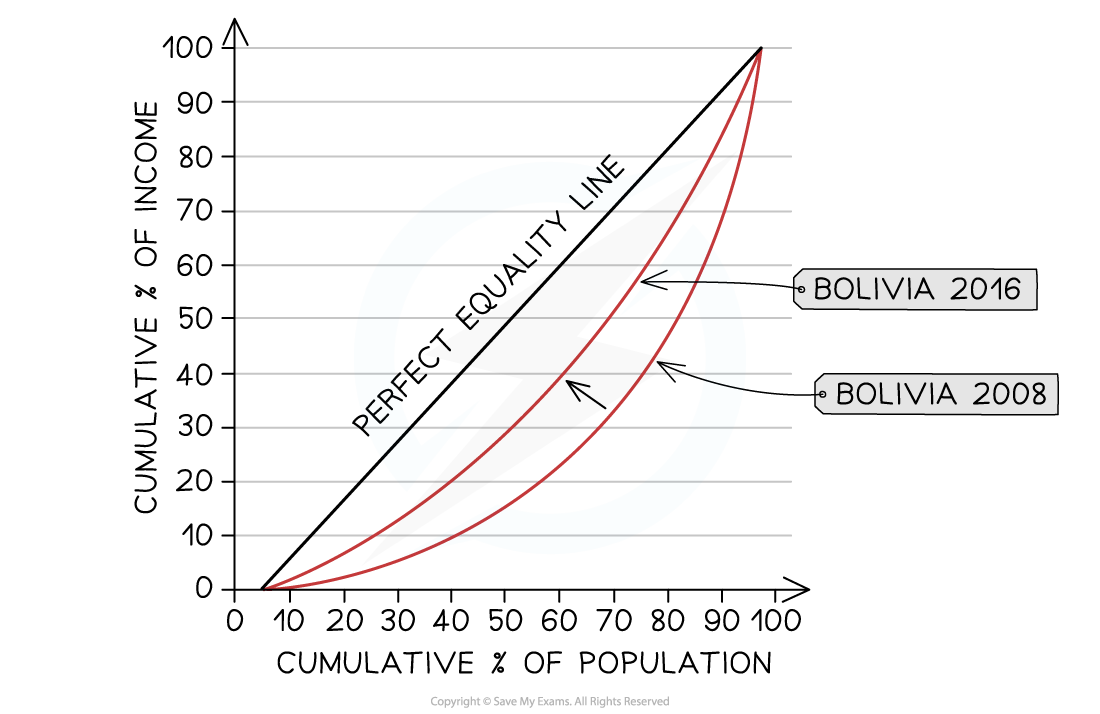Inequality & Poverty Terminology
- Equality describes situations where economic outcomes are similar for different people or different social groups
- Income equality would mean everyone, irrespective of their job, is paid the same
- Inequality in the distribution of income is one cause of absolute and relative poverty
- Equity refers to the idea of fairness and is a normative concept
- Equity in the distribution of income means that there is fairness in the wage differentials that exist in society e.g. those with higher qualifications or skills are paid more than those with less
- The size of acceptable wage differentials is a matter of much debate
- Income and wealth inequality are two different concepts
- Income inequality refers to the unequal distribution (flow) of income to households i.e rent, wages, interest and profit
- Wealth inequality refers to differences in the amount of assets that households own
- Absolute poverty is a situation where individuals cannot afford to acquire the basic necessities for a healthy and safe existence
- These necessities include shelter, water, nutrition, clothing and healthcare
- In 2022, the World Bank defined absolute poverty as anyone who was living on less than $1.90 a day (the so called international poverty line)
- Absolute poverty is more prevalent in developing countries than in developed ones
- Relative poverty is a situation where household income is a certain percentage less than the median household income in the economy
- Poverty in a household is considered relative to income levels in other households
- Households that are living with less than 50% of the median household income are considered to be in relative poverty
- Relative poverty is the main form of poverty that occurs in developed countries
Measuring Inequality - the Lorenz Curve & Gini Coefficient
- The two main measures of income inequality are the Lorenz Curve and the Gini coefficient
The Lorenz Curve
- The Lorenz Curve is a visual representation of the income inequality that exists between households in an economy
- Data is commonly presented in quintiles (population divided into 5 groups i.e 20%) or deciles (population divided into 10 groups i.e 10%)
- E.g. in 2020, 49% of the income flow in Bolivia went to the top 20% of households while only 4% went to the bottom 20%
- E.g. in 2020, 49% of the income flow in Bolivia went to the top 20% of households while only 4% went to the bottom 20%
- Perfect income distribution is not the goal (20 % of the population gets 20% of the income; 40% gets 40% percent of the income etc.)
- That would equate to socialism and completely remove incentives for work as everyone would be paid equally
- That would equate to socialism and completely remove incentives for work as everyone would be paid equally
- More equal income distribution is desired as it reduces poverty and social unrest
- What constitutes acceptable income equality is a normative economic issue
- What constitutes acceptable income equality is a normative economic issue

An illustration of Income Inequality for Bolivia (blue line) and Sweden (red line) and the UK (yellow line) using a Lorenz Curve Model. The income distribution in Bolivia is more unequal than that of Sweden
Diagram Analysis
- The line of equality represents perfect income distribution (not desirable)
- In Bolivia the bottom 20% of households receive 4% of the income flow while in Sweden they receive 9% of the income flow
- In the UK the top 10% of households receive 45% of the income flow while in Sweden they receive 25%
- Sweden has a more equal distribution of income than the UK
The Gini Coefficient
- The Lorenz curve can be used to calculate the Gini Coefficient

The Gini Coefficient is calculated using the area beneath the line of equality
Diagram Analysis
- A represents the area between the line of equality and Bolivia's Lorenz curve
- B represents the area under the Lorenz curve
- A value of 0 represents absolute equality (socialism) and 1 represents perfect inequality
- In 2017, Estonia's coefficient was 0.3 as compared with a value of 0.62 in South Africa
- The distribution of income in Estonia was more equitable than in South Africa
- Governments use progressive taxation and transfer payments to shift the Gini coefficient closer to zero
Worked Example
Using a Lorenz curve diagram, explain what happened to income inequality in Bolivia between 2008 and 2016 [4]
Income Gini Coefficient Data for Bolivia
| Income Gini Coefficient 2008 | 0.51 |
| Income Gini Coefficient 2016 | 0.43 |
Step 1: Determine if inequality has improved or worsened
The closer to zero, the closer the country is moving to perfect equality.
The situation in Bolivia has improved so the Lorenz curve is moving closer to the line of perfect equality
Step 2: Draw and label the Lorenz Curve for each year

(2 marks for a correctly labelled diagram with a shift inwards of the Lorenz curve)
Step 3: With reference to your diagram, explain what has happened to the income inequality between the two time periods
The closer the Gini coefficient is to zero, the more equal the distribution of income in a country. (1) Bolivia's Gini coefficient has moved closer to zero indicating that there is less income inequality in 2016 than there was in 2008 and this is illustrated by an inward shift of the Lorenz curve towards the line of perfect equality (1)
Measuring Poverty
- There are many single indicators of economic development. These can be used to compare the relative standing of countries at any point in time. They also serve to provide targets for improving the lives of citizens. Examples include
- Energy consumption per person
- The proportion of the population with access to clean water
- Number of girls completing primary education
- Another single indicator is the International Poverty Line (IPL)
- This is the absolute minimum level of income that a person must receive in order to meet the basic needs required for human survival - currently $1.90 a day
- This is the absolute minimum level of income that a person must receive in order to meet the basic needs required for human survival - currently $1.90 a day
- The Minimum Income Standard (MIS) is another useful indicator
- The Minimum Income Standard (MIS) identifies the lowest amount of income needed for what society views as an acceptable standard of living in the country
- The value differs from region to region as adjustments are made for those living in urban versus rural areas due to the different costs of living associated with each
- A composite indicator can provide more meaningful data for comparisons between countries
- One useful composite indicator is the Multi-dimensional Poverty Index (MPI)
- One useful composite indicator is the Multi-dimensional Poverty Index (MPI)
Characteristics of the MPI
- Launched in 2010 by the Oxford Poverty and Human Development Initiative at the University of Oxford
- The MPI uses a survey to measure the complexities of poor people’s lives, individually and collectively, each year
- The MPI tracks deprivation across three dimensions and 10 indicators
- Health (child mortality, nutrition)
- Education (years of schooling, enrolment)
- Living standards (water, sanitation, electricity, cooking fuel, housing, assets)
- The survey first identifies which of these 10 deprivations each household experiences
- Households are then categorised as poor if they suffer deprivations across 1/3 or more of the weighted indicators
- The MPI can focus in on regions, ethnicities and also any of the three dimensions
- This adaptability makes it a useful tool for policymakers and non-government organisation (NGOs) working to reduce poverty
Difficulties in Measuring Poverty
- Poverty is multi-dimensional concept and difficult to quantify
- Poverty is usually measured through self reported surveys and this gives rise to multiple discrepancies in - and between - countries
- Households who identify as poor may exhibit very different characteristics from each other
- Urban households may have very different ideas of their poverty level compared to rural households
- Urban areas tend to have higher immigrant households whose status can change relatively quickly as they seize opportunities
- Rural households may remain in long-term poverty
- Poverty data for different ages, gender and disabilities is not easily available